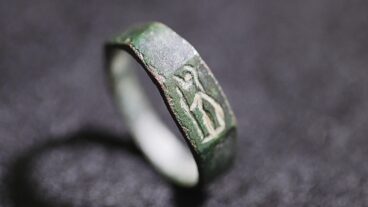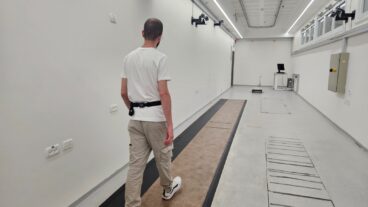A 3,500-year-old rare, bronze, horned bracelet discovered in an excavation in northern Israel this month is described as an “extraordinary, unique artifact that is fascinating archaeologists at the Israel Antiquities Authority.”

The archaeological excavations, funded by the Ministries of Transport and Housing, are situated southeast of Safed, in Ramat Razim. They are being held in the framework of regional development. New neighborhoods, commercial areas and a medical school are planned for the area.
Karen Covello-Paran, director of the excavation on behalf of the Israel Antiquities Authority reports: “We discovered a wide rare bracelet made of bronze. The ancient bracelet, which is extraordinarily well-preserved, is decorated with engravings and the top of it is adorned with a horned structure.
“At that time horns were the symbol of the storm-god and they represented power, fertility and law. The person who could afford such a bracelet was apparently very well-off financially, and it probably belonged to the village ruler. It is interesting to note that in the artwork of neighboring lands, gods and rulers were depicted wearing horned crowns; however, such a bracelet, and from an archaeological excavation at that, has never been found here.”
Another find at the site is a Canaanite scarab made of stone and engraved with Egyptian hieroglyphs. In antiquity scarabs were worn as pendants or were inlaid in rings, and they were used as a seal by the people who carried them or as a talisman with magical powers. These valuable finds indicate that the residents were also engaged in barter.
According to archaeologist Covello-Paran, “This is the first time that a 3,500 year old village has been excavated and exposed in the north of Israel… Here we have gained a first glimpse of life in the ancient rural hinterland in the north, and it turns out that it was more complex than we thought.
“The ancient inhabitants of Ramat Razim raised sheep and goats, and farmed. Numerous basalt querns that were used for grinding wheat into flour were found in the building. In addition, we also found large storage vessels that were used to store grain and liquids, which stood on the floor to a height of more than a meter. An ancient oven for cooking was found in one of the residential rooms alongside ceramic cookware and tools, including flint blades, and intact bronze implements such as a long needle (about six inches) for sewing sacks or treating skins, and a long decorated pin that was used to fasten a dress or gown.”
The Israel Antiquities Authority is working to integrate the site into the extensive development plans for Ramat Razim. They hope to make it into an attraction for visitors, alongside the research institute and medical school.












